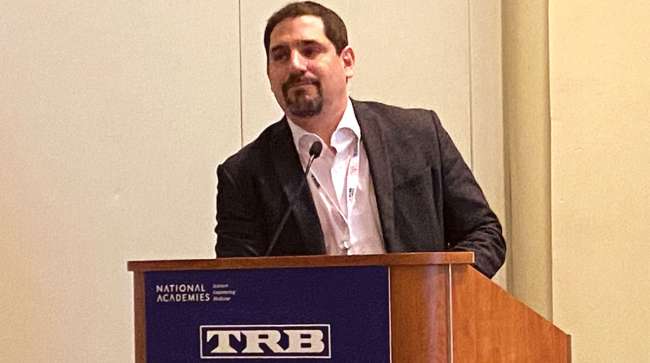Staff Reporter
COVID's Impact on Shopping, Supply Chain Remains Profound

[Stay on top of transportation news: Get TTNews in your inbox.]
WASHINGTON — The coronavirus pandemic had a profound impact on how shopping and supply chains operate, experts said Jan. 10 during a session at Transportation Research Board’s annual meeting.
“During COVID, because we were at home, e-commerce, online shopping, received a huge jump in how much sales they got,” Miguel Jaller, a researcher at the Institute of Transportation Studies at Davis University of California, said. “Now back in the last quarter of 2022 they’re almost all already at the same trajectory as they had been before the pandemic. And there are many things that are affecting those values.”
Jaller noted that at the start of the pandemic, online retail sales jumped in three months nearly as much as they did in the prior decade. But then the trends started to change as the pandemic progressed. The availability of vaccines and relaxation of pandemic restrictions led to the trends beginning to normalize. In the last year, market pressures furthered that.
“There are things like inflation, there are things like the money stopped flowing on the financial incentive that were provided in the U.S.,” Jaller said. “We have supply chain issues. Life is returning to a little bit normal. It’s now basically still growing at a double-digit, e-commerce is still getting a large market share, but it is not as profound as during those cases in the pandemic.”
Jaller and his team started taking a deeper look at the data to see what insights the boom in e-commerce could provide. They looked at socioeconomic factors like region, age and demographics. They also looked at commodity types and what e-commerce channels people were picking.

“There have been a few aspects of e-commerce shopping that have been less analyzed just because there has not been enough data at the level of the commodity or the choices,” Jaller said. “We want to know who was ordering what and what choices in terms of the deliveries they were making for that. And that is to inform our model and that’s also to inform if there may have been any challenges. We were discussing equity, and the pandemic highlighted a lot of equity issues in accessibility of goods and services.”
The research found that one of the biggest indicators of online shopping adoption was age. People under 55 were far more likely to start shopping online. The exception was medicine, which was consistent across age groups. It also found being a student full-time and being white were strongly associated with more online buying. The research further found owning a smartphone to shop online is much more predictive than fast internet.
“We see that propensity as the income goes high for them to use more of these services,” Jaller said. “There are also clear differences, especially for the delivery choice channel, affected by whether the people reside in rural, semi-urban and urban. For instance, demand for food in rural areas was almost nothing because there is not as much of those services there.”
The World Economic Forum found in a study released January 2020 that demand for last-mile delivery is expected to grow by 78% globally by 2030. This is being driven by emerging technologies and changes around consumer behavior and delivery methods in urban communities.
“It’s actually because of lot of reasons, like people are preferring to live in the urban region and also because of the newly developed emerging technologies and most likely there have been a lot of companies now, they’re trying to make a lot of contributions,” said Mehrdad Arabi, doctoral student at the University of Texas at Arlington, “like providing some expedited delivery services; so, the trend is going to be up.”
That means more delivery vehicles on the road.

Arabi speaks about delivery trends. (Connor D. Wolf/Transport Topics)
“By 2030 they’re predicting that delivery vehicles will increase by around 36%,” Arabi said, citing another study from the World Economic Forum. “We know that transportation is providing, also contributing, around 30% of the emissions. So due to COVID-19, emissions are going to increase by around 6 million tons by 2030, according to this study.”
Arabi warned these trends will have a disproportionate environmental impact on certain communities. The increased traffic congestion in urban environments and around warehouses and highways will cause more emissions — essentially worsening a problem they are already facing.
“From the environmental perspective, as of now, there is actually no zoning locations for the last-mile trucking facilities which could actually result in disproportionate impact to different communities, because of their geographical proximity,” Arabi said.
Want more news? Listen to today's daily briefing below or go here for more info:




